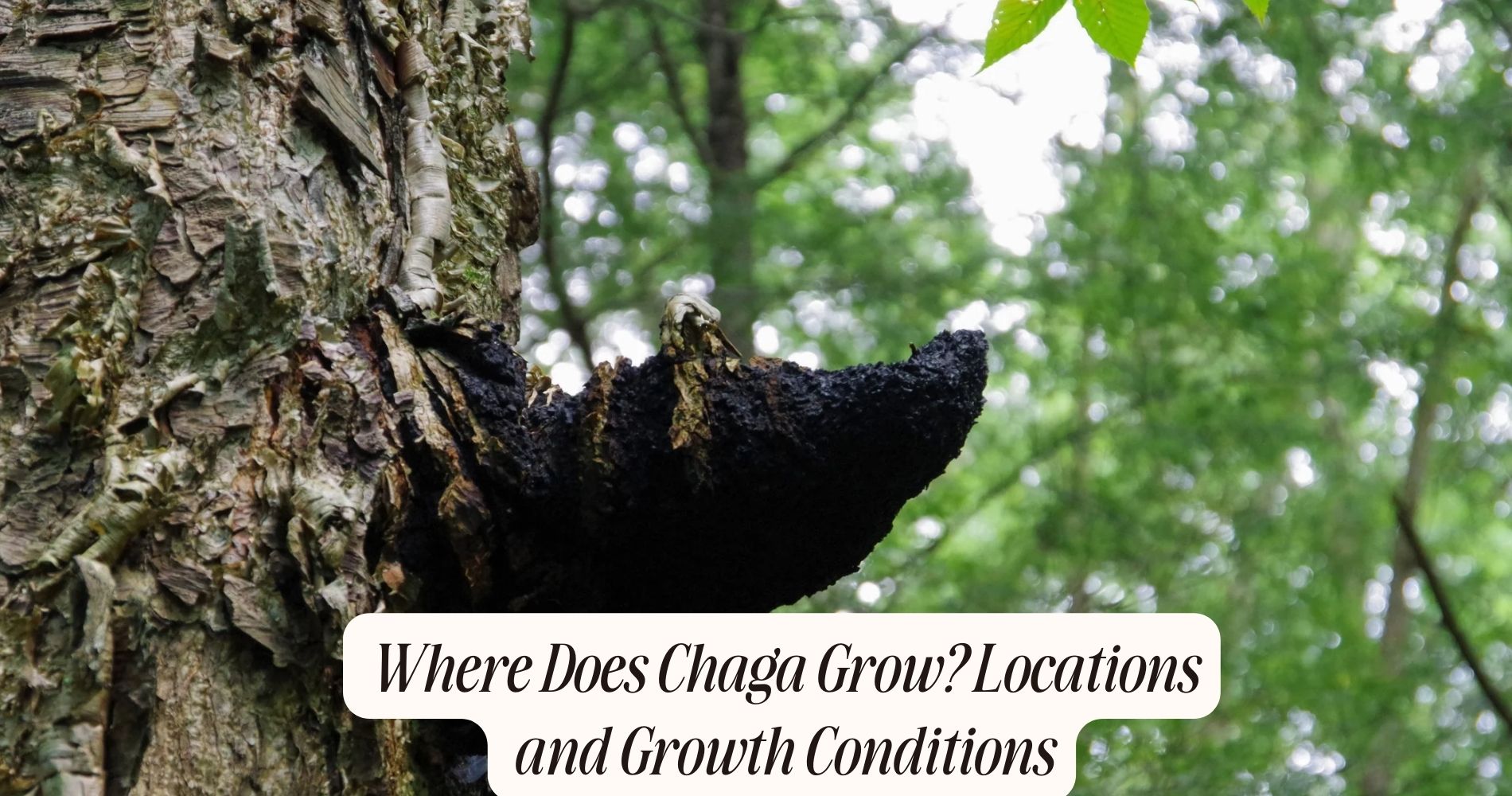
Where Does Chaga Grow? Locations and Growth Conditions
Where does chaga grow? You'll find Chaga mainly in the circumboreal regions of North America, Europe, and Asia. It thrives on mature birch trees like Betula pendula and Betula papyrifera in cold, harsh environments with ideal growth at temperatures between -40°F and 77°F and around 60-80% relative humidity. Chaga prefers slightly acidic, well-drained soil rich in organic matter and elevations between 300 to 1,500 meters above sea level. It flourishes under dense forest canopies with limited sunlight, and its seasonal growth patterns are closely tied to the boreal climate. If you explore further, you'll uncover more intricate details about this fascinating fungus.
Geographic Distribution
Chaga mainly grows in the circumboreal regions, encompassing the northern parts of North America, Europe, and Asia, where the climate provides the cold and harsh conditions necessary for its development.
You'll find it primarily on birch trees in these areas, flourishing in forests that offer the ideal environment. This growth pattern guarantees that Chaga is exposed to the stress factors needed for its beneficial compounds to develop most effectively.

Research indicates that the bioactive compounds in Chaga, such as polysaccharides, triterpenoids, and polyphenols, are responsible for its numerous health benefits. These compounds are more concentrated in Chaga found in these northern regions due to the specific climatic stresses. Consequently, Chaga harvesting in these locations isn't only traditional but also fundamental to guarantee the highest quality and efficacy of the mushroom.
When you're considering Chaga harvesting, it's vital to focus on sustainable practices. Overharvesting can deplete local populations and impact the ecosystem negatively.
Ideal Climate
You need to understand that Chaga thrives in specific climatic conditions, including ideal temperature and moisture levels.
Research indicates that Chaga prefers cold environments with high humidity, typically found in boreal forests.
Additionally, the fungus benefits from a balance of sunlight and shade, influencing its seasonal growth patterns.
Temperature and Moisture
Ideal climate conditions for Chaga growth require a balance of cold temperatures and moderate moisture levels.
Chaga, scientifically known as Inonotus obliquus, thrives in environments where the thermal preferences are maintained within a specific range. You'll find that Chaga prefers temperatures between -40°F and 77°F, with ideal growth occurring in areas that experience prolonged cold winters. These cold conditions facilitate the fungus's metabolic processes and enzymatic activities, vital for its development.
Humidity levels play a significant role in Chaga's growth. You need to guarantee that the environment maintains moderate moisture, as excessive dampness can lead to competing fungal growth, while too little moisture can hinder Chaga's ability to sustain itself.
Research indicates that an ideal relative humidity of around 60-80% is beneficial for Chaga. This range supports the mycelium's ability to extract nutrients effectively from the host tree, usually birch.
Sunlight and Shade
In evaluating sunlight and shade requirements for ideal Chaga growth, it's crucial to understand that this parasitic fungus flourishes in low-light conditions provided by dense forest canopies.
Chaga, scientifically known as Inonotus obliquus, exhibits remarkable shade tolerance, thriving in environments where direct sunlight exposure is minimal. This preference aligns with its natural habitat in boreal forests, where the thick canopy filters sunlight, creating a dimly lit understory.

To optimize Chaga cultivation, consider simulating these natural conditions. You should aim to establish Chaga in areas with limited sunlight exposure, mimicking the dense forest canopy. The fungus attaches to the host tree, primarily birch, and relies on the shaded environment to sustain its growth.
Research suggests that prolonged direct sunlight can hinder Chaga development, potentially affecting its bioactive compound concentration. Shade tolerance in Chaga is a critical aspect of its growth strategy.
By thriving under the forest canopy, Chaga avoids competition with photophilic organisms and capitalizes on the stable, humid microclimate. Understanding these specific light conditions is crucial for anyone looking to cultivate Chaga successfully.
Ensuring reduced sunlight exposure while maintaining adequate shade will greatly enhance Chaga's growth and health.
Seasonal Growth Patterns
Understanding Chaga's seasonal growth patterns necessitates a close examination of its ideal climate conditions, particularly the temperature fluctuations and precipitation levels characteristic of boreal forests.
Chaga (Inonotus obliquus) thrives in regions where winters are harsh and summers are relatively mild, typically found in the circumpolar boreal forests of the Northern Hemisphere. The growth cycles of Chaga are intricately linked to these seasonal changes, with the fungus exhibiting its most significant development during the colder months.
During winter, when temperatures plummet, Chaga enters a phase of reduced metabolic activity. This dormancy is essential for its survival and future growth. The snow cover acts as an insulator, protecting the fungus from extreme cold and desiccation.
As spring arrives, melting snow increases soil moisture, stimulating Chaga's metabolic processes. This period of increased hydration is important for the fungus to absorb nutrients and expand.
Throughout summer, moderate temperatures and consistent precipitation support steady growth.
Fall, with its cooler temperatures and reduced daylight, signals the Chaga to slow its activity, preparing for the upcoming winter.
Host Trees
You'll find that chaga primarily grows on birch trees, establishing a symbiotic relationship that's essential for its development.
Research indicates that birch trees provide the specific nutrients and environment chaga needs to thrive.
Additionally, host trees must meet particular conditions, such as age and health, to support chaga growth effectively.
Preferred Tree Species
Thriving primarily on birch trees, Chaga (Inonotus obliquus) demonstrates a marked preference for Betula species due to their high betulin content. This affinity allows Chaga to assimilate betulin into its structure, enhancing its medicinal benefits.
When engaging in chaga harvesting, it's essential to identify the correct tree species to guarantee ideal potency and efficacy. Betula species, such as Betula pendula (silver birch) and Betula papyrifera (paper birch), offer the most favorable conditions for Chaga growth.
Research indicates that Chaga also grows on other hardwood species, albeit less commonly. These include alder (Alnus spp.), beech (Fagus spp.), and elm (Ulmus spp.). However, the concentration of bioactive compounds like betulinic acid is considerably lower in Chaga harvested from these trees. Consequently, the medicinal benefits aren't as pronounced, making birch trees the preferred choice for both natural occurrence and intentional cultivation.

You'll find Chaga most abundantly in boreal forests and temperate zones where these birch species dominate. Proper identification and selective chaga harvesting from healthy, mature birch trees guarantee the sustainability of this valuable fungus.
Birch Tree Relationship
How does the symbiotic relationship between Chaga and birch trees contribute to the fungus's unique biochemical profile?
Chaga (Inonotus obliquus) primarily parasitizes birch trees (Betula spp.), extracting nutrients and bioactive compounds from its host. This relationship enables Chaga to synthesize a diverse array of phytochemicals, including betulinic acid, which it derives directly from the birch bark. Betulinic acid and its derivatives are essential to Chaga benefits, offering anti-inflammatory, antioxidant, and anticancer properties.
In this symbiotic interaction, Chaga also absorbs other important compounds like polyphenols and triterpenoids, enhancing its medicinal profile. The birch tree's rich biochemical environment therefore becomes a reservoir for Chaga's growth and development, leading to a fungus teeming with beneficial compounds. Research indicates that Chaga's unique biochemical profile is a direct result of its selective parasitism on birch trees.
When it comes to Chaga harvesting, understanding this symbiotic relationship is vital. Harvesters often target birch trees that exhibit ideal growth conditions for Chaga, ensuring the fungus is rich in bioactive compounds. Sustainable harvesting practices are essential to maintain this delicate balance, allowing both Chaga and its host trees to flourish.
Host Tree Requirements
For Chaga to thrive, it requires host trees with specific characteristics, primarily birch trees, which provide the ideal biochemical environment for the fungus's growth and development. Birch trees, particularly Betula spp., contain high levels of betulin, a compound that Chaga metabolizes into betulinic acid, contributing notably to its medicinal properties. This symbiotic relationship is essential for chaga cultivation, optimizing the production of bioactive compounds.
When selecting a host tree for chaga cultivation, you should focus on mature birch trees, typically over 40 years old, as they offer a more established biochemical milieu. These trees should exhibit signs of health and vigor, as the presence of diseases or considerable damage can inhibit the fungus's ability to colonize and thrive.
It's vital to take into account the geographical location, as birch trees in colder climates, such as those found in the boreal forests of Russia, Canada, and parts of the Northern United States, are more conducive to Chaga's growth. These regions provide the necessary cold stress that stimulates the birch tree to produce higher concentrations of betulin.
Soil Requirements
The ideal soil for Chaga growth is well-drained, slightly acidic, and rich in organic matter, providing necessary nutrients for its development.
You need to guarantee that the soil has an ideal soil pH ranging between 5.5 and 6.5. This acidity level is essential because it facilitates nutrient availability, allowing Chaga to absorb necessary minerals and compounds for its growth.
The soil should also exhibit high levels of organic matter. Organic matter decomposes and releases nutrients slowly, creating a fertile environment conducive to Chaga's needs.
You'll find that well-drained soil prevents waterlogging, which can otherwise lead to root diseases and negatively affect Chaga's growth. Additionally, this type of soil structure supports healthy microbial activity, further enhancing nutrient cycling and availability.
Research indicates that Chaga thrives in soils rich in important elements like nitrogen, phosphorus, and potassium. These nutrients are critical for cellular processes and overall health.
You should conduct soil tests to determine the nutrient profile and adjust it accordingly with organic amendments or fertilizers. By focusing on these specific soil requirements, you can greatly improve the chances of successful Chaga cultivation.
Altitude Preferences
After ensuring ideal soil conditions, you'll find that altitude greatly impacts Chaga growth, as it tends to thrive in cooler, temperate regions typically found at higher elevations.
Scientific research indicates that Chaga, a parasitic fungus, prefers an elevation range between 300 to 1,500 meters above sea level. This range provides a stable environment with lower temperatures and higher humidity levels, which are conducive to its development.
The altitude impact on Chaga is significant due to the microclimatic conditions present at these elevations. Cooler temperatures slow down competing fungal growth and reduce the presence of pests, allowing Chaga to establish itself more effectively.
Additionally, high-altitude regions often have pristine air quality and lower pollution levels, which can positively influence the purity and potency of the Chaga.

You'll also notice that the tree species composition changes with altitude, indirectly affecting Chaga. Birch trees, the primary hosts for Chaga, are more prevalent at these elevations in temperate zones.
The consistent presence of birch trees at higher elevations creates an ideal symbiotic environment for Chaga, ensuring its proliferation and sustainability in these regions.
Thus, considering altitude preferences is essential for anyone looking to locate or cultivate Chaga.
Seasonal Growth Patterns
Understanding Chaga's seasonal growth patterns is vital, as its development is heavily influenced by the varying climatic conditions throughout the year. Chaga exhibits distinct growth cycles that are closely aligned with seasonal variations, primarily due to fluctuations in temperature and moisture levels.
During the spring and summer months, Chaga's growth accelerates, benefiting from increased sunlight and warmer temperatures. These conditions enhance the metabolic activities within the fungal mycelium, leading to rapid expansion. Additionally, the higher humidity levels in these seasons contribute to the ideal moisture content necessary for Chaga's development.
Conversely, in autumn and winter, Chaga's growth slows considerably. The cooler temperatures and reduced daylight hours trigger a dormancy phase, wherein cellular activity diminishes. This period of reduced growth is vital for Chaga, as it allows the fungus to conserve energy and maintain resilience against harsh winter conditions.
The snow cover during winter also provides insulation, protecting the fungus from extreme cold and dehydration.
Frequently Asked Questions
What Are the Medicinal Properties of Chaga?
Chaga offers anti-inflammatory benefits, bolstering your immune system. Scientific research highlights its rich beta-glucans, antioxidants, and polysaccharides, which enhance immune response, reduce inflammation, and combat oxidative stress, contributing to overall health and disease prevention.
How Long Does Chaga Take to Mature?
Chaga takes 3-5 years to mature, depending on growth timeline and environmental factors. You'll find that temperature, humidity, and host tree health greatly impact development, as indicated by research-based analyses conducted in various forests.
Can Chaga Be Cultivated Commercially?
Yes, chaga farming for commercial viability is possible. Research indicates controlled environments can replicate natural conditions, but challenges include time to maturity and susceptibility to contamination, requiring meticulous cultivation techniques and consistent monitoring for successful harvests.
What Are the Traditional Uses of Chaga in Different Cultures?
You'll find chaga's cultural significance spans various cultures. Historically, people used it for medicinal purposes, including boosting immunity and treating digestive issues. Research shows its bioactive compounds provide antioxidant, anti-inflammatory, and antimicrobial benefits.
How Do You Sustainably Harvest Chaga?
To sustainably harvest chaga, you should employ precise harvesting techniques. Avoid cutting too deep into the tree, and leave at least 15-20% of the fungus to guarantee regrowth. These sustainable practices maintain ecological balance and promote chaga's longevity.
Conclusion
You've discovered that chaga thrives primarily in cold, northern climates, especially across Canada, Russia, and parts of Northern Europe.
You'll need to find it on birch trees, its preferred host, in well-drained, slightly acidic soils.
Altitudinally, chaga favors low to mid-range elevations.
Although it grows year-round, ideal harvesting occurs in late fall and winter.
By understanding these precise conditions, you can effectively locate and sustainably harvest this valuable medicinal fungus.




